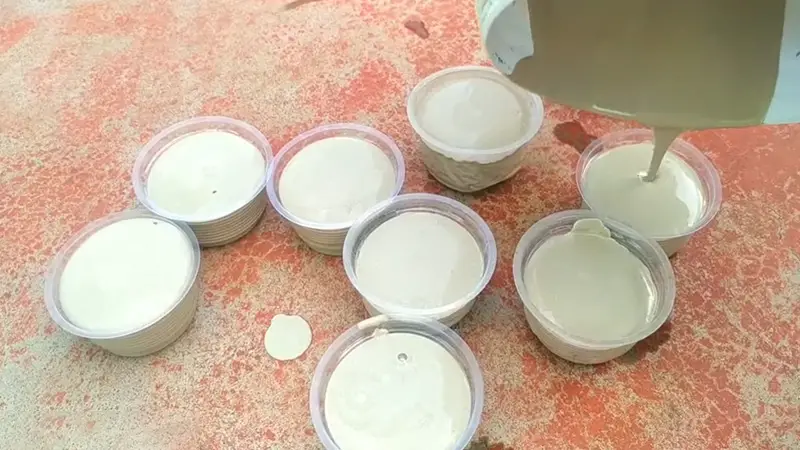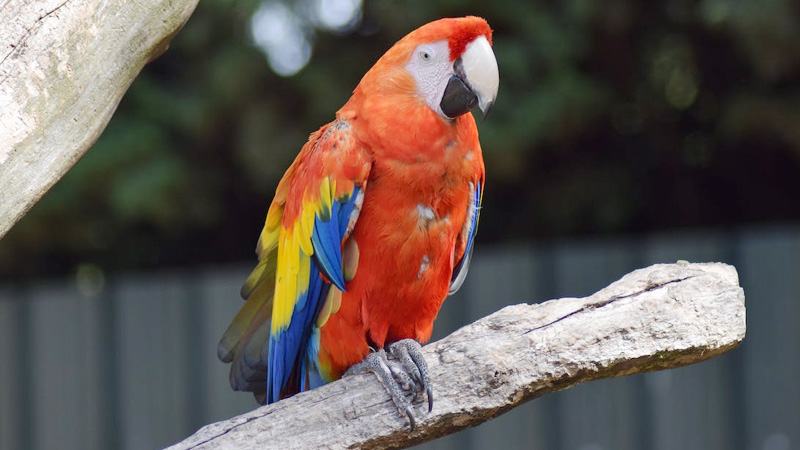Parrots, as highly intelligent and playful birds, require a well-balanced diet to thrive in captivity. One vital component of their nutrition is calcium, which is essential for maintaining strong bones, beaks, and feathers.
While commercial calcium blocks are readily available, making a homemade calcium block for your parrot can be a cost-effective and enjoyable project. In this article, we will guide you through how to make a calcium block for parrots.

How To Make A Calcium Block For Parrots?
Below is the process of creating a homemade calcium block to supplement your parrot’s diet:
Materials Needed
- Calcium supplement powder (specifically formulated for birds)
- Organic eggshells
- Unflavored gelatin or agar-agar powder
- Food coloring (optional)
- Water
- Small mixing bowl
- Measuring spoon
- Cookie cutters or silicone molds
- Parchment paper or wax paper
- Mixing spoon
- Cooling rack
Gather and Prepare the Eggshells
- Collect clean and organic eggshells from eggs used in your household.
- Rinse the eggshells thoroughly to remove any residual egg content. Boil the eggshells for about 10 minutes to sterilize them.
- Once cooled, crush the eggshells into small pieces or grind them into a fine powder using a mortar and pestle or a food processor.
Prepare the Gelatin Mixture
- In a small mixing bowl, dissolve the unflavored gelatin or agar-agar powder in water according to the instructions on the package.
- If desired, add a few drops of food coloring to the mixture to make it more visually appealing for your parrot.
- Stir the mixture well until the gelatin or agar-agar is completely dissolved.
Add the Calcium Supplement
- Gradually add the calcium supplement powder to the gelatin mixture. Stir continuously to ensure an even distribution of the calcium powder.
- The amount of calcium supplement to add depends on the instructions provided on the package or as recommended by your avian veterinarian. Typically, it is around 1 teaspoon per cup of gelatin mixture.
Incorporate the Eggshells
- Add the crushed eggshells or eggshell powder to the gelatin mixture.
- Stir thoroughly to ensure the eggshells are evenly distributed.
Shape the Calcium Block
- Line a baking sheet or flat surface with parchment paper or wax paper to prevent sticking.
- Pour the gelatin mixture onto the lined surface and spread it evenly to your desired thickness using a spoon or spatula. Alternatively, you can use cookie cutters or silicone molds to create fun shapes for your parrot.
Allow the Block to Set
- Place the baking sheet or molds in the refrigerator.
- Allow the calcium blocks to cool and set for several hours or overnight, depending on the gelatin or agar-agar instructions.
Remove and Store the Calcium Blocks
- Once the blocks are fully set, remove them from the molds or cut them into smaller pieces using a knife or cookie cutter. Place the calcium blocks on a cooling rack to air dry for an additional 24 hours.
- Store the blocks in an airtight container or Ziploc bag to maintain freshness and prevent moisture buildup.
Why Use a Calcium Block?

Using a calcium block for parrots offers several benefits:
Promotes Strong Bones and Beaks
Calcium is a fundamental mineral necessary for maintaining healthy bones and beaks in parrots. A calcium block provides a convenient and reliable source of this essential nutrient, ensuring that your parrot receives an adequate amount to support skeletal strength and integrity.
Prevents Calcium Deficiency
Calcium deficiency can lead to various health issues in parrots, including weak bones, beak deformities, and feather problems. Offering a calcium block helps prevent these deficiencies by supplementing your parrot’s regular diet with an additional source of calcium.
Supports Eggshell Formation
Female parrots require increased calcium during egg-laying periods. Providing a calcium block helps meet their elevated calcium needs, contributing to the formation of strong and healthy eggshells. This is particularly important for breeding parrots.
Encourages Natural Foraging Behavior
Parrots are intelligent and curious birds that thrive on mental stimulation. Calcium blocks can be designed as interactive toys or placed strategically within the enclosure, encouraging your parrot to engage in natural foraging behaviors. This promotes mental enrichment and helps prevent boredom.
Cost-Effective and Long-Lasting
Homemade calcium blocks can be a cost-effective alternative to store-bought options. By making your own blocks, you have control over the ingredients and can customize them according to your parrot’s preferences.
Additionally, calcium blocks are typically long-lasting, providing a continuous source of calcium over an extended period.
Easy to Monitor Calcium Intake
Calcium blocks provide a measurable and controlled amount of calcium. This makes it easier to monitor your parrot’s calcium intake and ensure they are receiving an appropriate and consistent supply of this essential mineral.
It is important to note that while a calcium block is beneficial, it should not be the sole source of calcium in your parrot’s diet. A well-balanced diet that includes calcium-rich foods like dark leafy greens, broccoli, and other safe fruits and vegetables.
Consult with your avian veterinarian to determine the specific calcium requirements and dietary recommendations for your parrot.
What Is Calcium Deficiency in Birds?

Calcium deficiency, also known as hypocalcemia, is a condition that occurs when a bird’s body does not receive an adequate amount of calcium.
Calcium deficiency can affect various species of birds, including parrots, and it can lead to several health issues. Here are some key aspects of calcium deficiency in birds:
Causes of Calcium Deficiency
Calcium deficiency can result from multiple factors, including an imbalanced diet lacking in calcium-rich foods, inadequate absorption of calcium from the digestive system, or increased demand for calcium during specific life stages, such as breeding or egg-laying.
Symptoms of Calcium Deficiency
The symptoms of calcium deficiency in birds can vary depending on the severity and duration of the deficiency. Common signs include weakness, lethargy, reduced appetite, weight loss, tremors or muscle spasms, difficulty in perching or walking, seizures, and even sudden death.
Birds with calcium deficiency may also exhibit beak abnormalities, such as soft or deformed beaks, and feather-related problems like poor feather quality or excessive feather plucking.
Increased Risk Factors
Certain factors can increase the risk of calcium deficiency in birds. These include insufficient access to natural sunlight or full-spectrum UV lighting, which is essential for the synthesis of vitamin D3 necessary for calcium absorption.
Breeding or egg-laying birds also have higher calcium requirements, and if not met, they can be more prone to calcium deficiency.
Calcium and Egg Laying
Female birds, including parrots, require elevated levels of calcium during the egg-laying period. Calcium is vital for the formation of strong eggshells.
If a female bird does not receive enough calcium during this time, she may lay eggs with thin or fragile shells, which can lead to complications, including egg binding.
Prevention and Treatment
Preventing calcium deficiency in birds involves providing a well-balanced diet that includes calcium-rich foods, such as dark leafy greens, broccoli, and calcium-fortified bird pellets.
Ensuring access to natural sunlight or UV lighting is also crucial. If a bird is diagnosed with calcium deficiency, the veterinarian may recommend dietary adjustments, calcium supplements, and, in severe cases, intravenous calcium administration.
If you suspect that your bird may be experiencing calcium deficiency or observe any related symptoms, it is essential to consult with an avian veterinarian promptly.
They can assess the bird’s condition, conduct necessary tests, and provide appropriate treatment recommendations to address the deficiency and improve the bird’s overall health and well-being.
How Do I Give My Parrot Calcium?
Giving your parrot calcium can be done through various methods. Here are a few effective ways to ensure your parrot receives an adequate amount of calcium:
Calcium Blocks
As discussed earlier, providing a calcium block is an excellent way to offer a supplemental source of calcium to your parrot. Place the block in your parrot’s cage or attach it to the side of the enclosure.
Parrots will naturally nibble and chew on the block, ingesting the calcium powder and benefiting from its nutritional properties.
Calcium-Rich Foods
Incorporate calcium-rich foods into your parrot’s diet. Offer a variety of dark leafy greens such as kale, spinach, and dandelion greens, as these are excellent sources of natural calcium.
Other calcium-rich foods include broccoli, bok choy, and calcium-fortified bird pellets. Consult your avian veterinarian for specific dietary recommendations and portion sizes based on your parrot’s species and size.
Eggshells
Crushed, sterilized, and finely ground eggshells can be added to your parrot’s food as a calcium supplement. Ensure the eggshells are clean and free from any residual egg content.
Process them into a powder using a mortar and pestle or a food processor, and sprinkle a small amount over your parrot’s fresh food. Monitor your parrot’s acceptance of the eggshells and adjust the quantity accordingly.
Liquid Calcium Supplements
Liquid calcium supplements formulated for birds can be added to your parrot’s drinking water or food. Follow the instructions provided by the manufacturer or consult your avian veterinarian for the appropriate dosage.
Calcium-Rich Cuttlebones
Cuttlebones, which are the internal shells of cuttlefish, are commonly available in pet stores and are an additional source of calcium. They can be placed in your parrot’s cage, allowing your parrot to chew on them and consume the calcium-rich layers.
Remember, while calcium is essential, it is crucial to maintain a balanced diet for your parrot. Consult with an avian veterinarian to determine the appropriate calcium intake and dietary requirements for your specific parrot species, age, and health condition.
Regular monitoring and periodic check-ups will ensure that your parrot’s calcium needs are being met effectively.
FAQs
Calcium is crucial for parrots as it plays a vital role in maintaining their overall health. It is necessary for the development and maintenance of strong bones, beaks, and feathers. Parrots that lack sufficient calcium in their diet may be at risk of developing skeletal problems, such as brittle bones or beak deformities.
Yes, using store-bought calcium supplements is a viable option. There are various calcium supplements specifically formulated for birds available in pet stores and online. These supplements often come in the form of powder or liquid, making it easy to incorporate into your parrot’s diet.
The frequency of offering a calcium block to your parrot will depend on various factors, including your bird’s specific dietary needs and preferences. As a general guideline, a calcium block can be provided to your parrot a few times a week.
When preparing a homemade calcium block, it is important to ensure the ingredients used are safe and suitable for parrots. Avoid using any additives or ingredients that are toxic to birds, such as artificial sweeteners, flavorings, or colorings.
Symptoms of calcium deficiency in parrots can vary but may include weakness, lethargy, decreased appetite, increased susceptibility to fractures, tremors, and muscle spasms. Beak deformities or softening, brittle or spongy bones, and feather abnormalities can also indicate a lack of calcium.
Final Words
So, now you know how to make a calcium block for parrots. Providing your parrot with a homemade calcium block is an excellent way to supplement their diet and ensure they receive the essential nutrients they need to stay healthy.
Remember, a calcium block should be offered alongside a well-balanced diet that includes a variety of fruits, vegetables, grains, and high-quality parrot pellets.
Regularly monitor your parrot’s calcium intake and consult with an avian veterinarian for any specific dietary requirements. By following this step-by-step guide, you can create a customized and cost-effective calcium block that will contribute to your parrot’s overall well-being.